The Didactic Potential of Paleontological Immovable Heritage for Secondary Education (Middle School and High School) Students in Spain: Assessment from Learning and Research Approaches
Abstract
1. Introduction

2. Objectives
3. Contextualization of Immovable Paleontological Heritage in Field Educational Activities
4. Paleontology and Environmental Education: Paleontological Heritage as an Educational Resource in the Framework of the 2030 Agenda
5. Paleontological Sites and Curricular Contents
6. Expert Form: Perception of the Didactic Advantages Offered by Paleontological Sites When Developing Educational Activities and Projects In Situ
- Methodology and evaluation instruments
- Analysis and discussion of responses
7. Discussion
8. Conclusions
- -
- Research and contextualization activities prior to the site visit provide a solid foundation of knowledge and foster interest and participation.
- -
- Hands-on paleontology workshops, where students can experiment with fossil replicas, excavation tools, and recording techniques, will give them insight into the work of paleontologists and prepare them for the site experience.
- -
- Keeping a field notebook with observations, drawings, and reflections during the activity will be a valuable tool for reinforcing knowledge and reflecting on the experience after the visit.
- -
- After the field visit, it is important to produce a final, evaluable product that includes the concepts and ideas discussed in the previous activities (fossil analysis, photographs, drawings and diagrams, or replicas and casts) to improve scientific communication and teamwork.
Author Contributions
Funding
Data Availability Statement
Acknowledgments
Conflicts of Interest
Appendix A
| Biology and Geology-4ºESO (Students Between 15 and 16 Years Old) | |
|---|---|
| Specific competence | Evaluation criteria |
| 1. Interpret and transmit scientific information and data, arguing about them and using different formats, to analyze concepts and processes of biological and geological sciences. | 1.1. Analyze biological and geological concepts and processes interpreting information in different formats (models, graphs, tables, diagrams, formulas, diagrams, symbols, web pages, etc.), maintaining a critical attitude, obtaining conclusions and forming informed opinions. [...] 1.4. Elaborate hypotheses in a scientific way and be able to contrast them through experimentation, observation or argumentation. |
| 2. Identify, locate and select information, contrasting its veracity, organizing and critically evaluating it, to solve questions related to biological and geological sciences. | 2.1. Solve questions and delve into biological and geological aspects by locating, selecting, organizing and critically analyzing information from different sources and citing them with respect for intellectual property. 2.2. Contrast the veracity of information on biological and geological topics or scientific works, using reliable sources and adopting a critical and skeptical attitude towards information without a scientific basis such as pseudoscience, conspiracy theories, unfounded beliefs, hoaxes, etc. 2.3. Value the contribution of science to society and the work of the people dedicated to it, understanding research as a collective and interdisciplinary work in constant evolution. |
| 3. Plan and develop research projects, following the steps of scientific methodologies and cooperating, when necessary, to investigate aspects related to geological and biological sciences. | 3.1. Pose questions and hypotheses that can be answered or contrasted using scientific methods, in the explanation of biological and geological phenomena and the realization of predictions about them. 3.2. Design the experimentation, data collection and analysis of biological and geological phenomena in a way that allows answering specific questions and contrasting a hypothesis raised avoiding biases. 3.3. Perform experiments and take quantitative or qualitative data on biological and geological phenomena using the appropriate instruments, tools or techniques with correctness and precision. [...] 3.5. Cooperate and collaborate in the different phases of a scientific project to work more efficiently, valuing the importance of cooperation in research. |
| 4. Use computational reasoning and thinking, critically analyzing answers and solutions and reformulating the procedure, if necessary, to solve problems or give explanation to everyday life processes related to biology and geology. | 4.1. Solve problems or explain biological or geological processes using knowledge, data and information provided by the teacher, logical reasoning, computational thinking or digital resources. 4.2. Critically analyze the solution to a problem about biological and geological phenomena, changing the procedures used or the conclusions if the solution is not feasible or in the face of new data provided later. |
| 5. Analyze the effects of certain actions on the environment and health, based on the fundamentals of biological and earth sciences, to promote and adopt habits that avoid or minimize negative environmental impacts, are compatible with sustainable development and allow maintaining and improving health. | 5.1. Identify the possible natural hazards that are enhanced by certain human actions in a geographic area, considering its lithological characteristics, relief, vegetation and socioeconomic factors. |
| 6. Analyze the elements of a specific landscape valuing it as natural heritage and using knowledge of geology and earth sciences to explain its geological history, propose actions aimed at its protection and identify possible natural risks. | 6.1. Deduce and explain the geological history of a relief identifying its most relevant elements from cuts, maps or other geological information systems and using reasoning, basic geological principles (horizontality, superposition, actualism, etc.) and the most relevant geological theories. |
| Biology and Geology-4ºESO (Students Between 15 and 16 Years Old) |
|---|
| Basic knowledge (contents) |
| A. Scientific project. |
| - Formulation of questions, hypotheses and conjectures: approach with scientific perspective. |
| [...] |
| - Reliable sources of scientific information: recognition and use. |
| - Experimental controls (positive and negative): design and argumentation about their importance for obtaining objective and reliable scientific results. |
| - Answering scientific questions through experimentation and field work: use of the necessary instruments and spaces (laboratory, classrooms, environment, etc.) appropriately and accurately. |
| - Methods of observation and data collection of natural phenomena. |
| - Methods of analysis of results and differentiation between correlation and causation. |
| - Scientific work and people dedicated to science: contribution to biological and geological sciences and social importance. |
| - The historical evolution of scientific knowledge: science as a collective, interdisciplinary work in continuous construction. |
| B. Genetics and evolution. |
| - Understanding of evolutionary facts, study and evaluation of the mechanisms of evolution. |
| C. Geology. |
| - Relief and landscape: differences, their importance as resources and factors involved in their formation and modeling. |
| […] |
| - Study of the global effects of the dynamics of the geosphere from the perspective of plate tectonics. |
| - External and internal geological processes: differences and relationship with natural hazards. |
| - Prevention measures and risk maps. |
| - Geological slices: interpretation and tracing of the geological history reflect by applying the principles of the study of the Earth’s history (horizontality, superposition, intersection, faunal succession, etc.). |
| - Geological time, location of important geological and biological events. Guiding fossils. |
| D. The Earth in the universe. |
| - Appreciation of the habitability of the Earth and its fragility and the importance of caring for the environment. |
| Biology, Geology and Environmental Sciences–1ºBachillerato (Students Between 16 and 17 Years Old) | |
|---|---|
| Specific competence | Evaluation criteria |
| 1. Interpret and transmit scientific information and data, arguing about them with precision and using different formats to analyze processes, methods, experiments or results of biological, geological and environmental sciences. | 1.1. Critically analyze concepts and processes related to the knowledge of the subject, interpreting information in different formats (models, graphs, tables, diagrams, formulas, diagrams). [...] |
| 2. Locate and use reliable sources, identifying, selecting and organizing information, critically evaluating it and contrasting its veracity, to solve questions posed related to biological, geological and environmental sciences in an autonomous way. | 2.1. Raise and solve questions related to the knowledge of the subject, locating and citing appropriate sources and selecting, organizing and critically analyzing the information. 2.2. Contrast and justify the veracity of information related to the knowledge of the subject, using reliable sources and adopting a critical and skeptical attitude towards information without a scientific basis such as pseudo sciences, conspiracy theories, unfounded beliefs, hoaxes, etc. 2.3. Argue about the contribution of science to society and the work of people dedicated to it, highlighting the role of women and understanding research as a collective and interdisciplinary work in constant evolution and influenced by the political context and economic resources. |
| 3. Design, plan and develop research projects following the steps of scientific methodologies, considering the available resources in a realistic way and looking for ways of collaboration, to investigate aspects related to biological, geological and environmental sciences. | 3.1. To pose questions, make predictions and formulate hypotheses that can be answered or contrasted, using scientific methods and that try to explain biological, geological or environmental phenomena. 3.2. Design the experimentation, data collection and analysis of biological, geological and environmental phenomena and select the necessary instruments to answer specific questions and test a hypothesis, minimizing biases as much as possible. 3.3. Perform experiments and take quantitative and qualitative data on biological, geological and environmental phenomena, selecting and using the appropriate instruments, tools or techniques with correctness and accuracy. 3.4. Interpret and analyze results obtained in a research project using, when necessary, mathematical and technological tools, recognizing their scope and limitations and obtaining reasoned and substantiated conclusions or assessing the impossibility of doing so. 3.5. Establish collaborations inside and outside the educational center in the different phases of the scientific project to work more efficiently, using the appropriate technological tools, valuing the importance of cooperation in research, respecting diversity and favoring inclusion. |
| 4. Seek and use strategies in problem solving, critically analyzing the solutions and answers found and reformulating the procedure, if necessary, to explain phenomena related to biological, geological and environmental sciences. | 4.1. Solve problems or explain biological, geological or environmental processes, using various resources such as own knowledge, collected data and information, logical reasoning, computational thinking or digital tools. 4.2. Critically analyze the solution to a problem on biological, geological or environmental phenomena and modify the procedures used or the conclusions obtained if such solution is not feasible or in the face of new data provided or collected subsequently. |
| 5. Design, promote and implement initiatives related to environmental conservation, sustainability and health, based on the fundamentals of biological, geological and environmental sciences, to promote sustainable and healthy lifestyles. | 5.1. Analyze the causes and ecological, social and economic consequences of the main environmental problems from an individual, local and global perspective, conceiving them as major challenges of humanity and based on scientific data and knowledge of the subject. 5.2. Propose and implement sustainable and healthy habits and initiatives at the local level and argue about their positive effects and the urgency of adopting them based on the knowledge of the subject. |
| 6. Analyze the elements of the geologic record using scientific fundamentals, to relate them to the major events that have occurred throughout the Earth’s history and to the temporal magnitude in which they occurred. | 6.1. Relate major events in Earth’s history to selected elements of the geologic record and to events occurring today, using basic geologic principles and logical reasoning. 6.2. Solve dating problems by analyzing elements of the geologic and fossil record and applying dating methods. |
| Biology, Geology and Environmental Sciences–1ºBachillerato (Students Between 16 and 17 Years Old) |
|---|
| Basic knowledge (contents) |
| A. Scientific project. |
| - Hypotheses, questions, problems and conjectures: approach with a scientific perspective. |
| - Strategies for information search, collaboration, communication and interaction with scientific institutions: digital tools, presentation formats of processes, results and ideas (slides, graphs, videos, posters, reports and others). |
| - Reliable sources of information: search, recognition and use. |
| - Laboratory or field scientific experiments: design, planning and realization. Hypothesis testing. Experimental controls. |
| - Methods of analysis of scientific results: organization, representation and statistical tools. |
| - Scientific communication strategies: scientific vocabulary, formats (reports, videos, models, graphs and others) and digital tools. |
| - Scientific work and people dedicated to science: contribution to biological, geological and environmental sciences and social importance. The role of women in science. |
| - The historical evolution of scientific knowledge: science as a collective, interdisciplinary work in continuous construction. |
| B. Ecology and sustainability. |
| - The environment as an economic and social driver: importance of environmental impact assessment and sustainable resources and waste management. The relationship between environmental, human and other living beings’ health: one health. |
| - Sustainability of daily activities: use of sustainability indicators, lifestyles compatible and consistent with a sustainable development model. Concept of ecological footprint. |
| - Local and global initiatives to promote a sustainable development model. |
| C. History of the Earth and life. |
| - Geologic time: magnitude, scale and dating methods. Problems of absolute and relative dating. |
| - The history of the Earth: major geological events. |
| - Methods and principles for the study of the geologic record: reconstruction of the geologic history of an area. Geological principles. |
| - The history of life on Earth: major changes in the major groups of living things and justification from the evolutionary perspective. |
| - The main taxonomic groups: fundamental characteristics. Importance of biodiversity conservation. |
| D. Terrestrial dynamics and composition. |
| - Structure, composition and dynamics of the geosphere. Direct and indirect methods of study. |
| - Internal geological processes, relief and their relation to plate tectonics. Types of edges, reliefs, seismic and volcanic activity and resulting rocks in each of them. |
| - External geological processes: causal agents and consequences on relief. Main forms of relief modeling and geomorphology. |
| - Edaphogenesis: soil forming factors and processes. Edaphodiversity and the importance of its conservation. |
| - Natural hazards: relationship with geological processes and human activities. Prediction, prevention and correction strategies. |
| - Classification and identification of rocks: according to their origin and composition. The lithological cycle. |
| - Chemical-structural classification and identification of minerals and rocks. |
| - The importance of minerals and rocks: daily uses. Their exploitation and responsible use. |
| - The importance of conservation of the geological heritage. |
| Geology and Environmental Sciences–2ºBachillerato (Students Between 17 and 18 Years Old) | |
|---|---|
| Specific competence | Evaluation criteria |
| 1. Interpret and accurately transmit information and data extracted from scientific works to analyze concepts, processes, methods, experiments or results related to geological and environmental sciences. | 1.1. Critically analyze concepts and processes, related to the knowledge of the subject, selecting and interpreting information in various formats such as maps (topographic, hydrographic, geological, vegetation, etc.), slices, models, flow charts or others. 1.2. Communicate information or reasoned opinions related to the knowledge of the subject, transmitting them in a clear and rigorous manner and using the appropriate vocabulary and formats such as maps (topographic, hydrographic, geological, vegetation, etc.), cuts, models, flow charts, or others and responding accurately to questions that may arise during the presentation. 1.3. Conduct scientific discussions on aspects related to the knowledge of the subject considering the strengths and weaknesses of different positions in a reasoned manner and with a receptive and respectful attitude towards the opinion of others. |
| 2. Locate and use reliable sources, identifying, selecting and organizing information, critically evaluating it and contrasting its veracity, to solve questions posed autonomously and create content related to geological and environmental sciences. | 2.1. Raise and solve questions and create content related to the knowledge of the subject, locating and citing sources appropriately, selecting, organizing and critically analyzing the information. 2.2. Contrast and justify the veracity of information related to the knowledge of the subject, using reliable sources, providing data and adopting a critical and skeptical attitude towards information without a scientific basis such as pseudo sciences, conspiracy theories, unfounded beliefs, hoaxes, etc. |
| 3. Critically analyze results of research or divulgation works related to geological and environmental sciences checking if they correctly follow the steps of scientific methods to evaluate the reliability of their conclusions. | 3.1. To evaluate the reliability of the conclusions of research or scientific dissemination work related to the knowledge of the subject of Geology and Environmental Sciences according to the interpretation of the results obtained. 3.2. Argue, using specific examples, about the contribution of science to society and the work of the people dedicated to it, highlighting the role of women and understanding research as a collective and interdisciplinary work in constant evolution influenced by the political and social context and economic resources. |
| 4. To pose and solve problems, seeking and using appropriate strategies, critically analyzing the solutions and reformulating the procedure, if necessary, to explain phenomena related to geological and environmental sciences. | 4.1. Explain phenomena related to the knowledge of the subject of Geology and Environmental Sciences through the approach and resolution of problems, seeking and using appropriate strategies and resources. 4.2. Critically analyze the solution to a problem related to the knowledge of the subject of Geology and Environmental Sciences and reformulate the procedures used or conclusions if such solution is not feasible or in the face of new data provided or found later. |
| 5. Analyze the impacts of certain actions on the environment or the availability of resources through field observations and information in different formats and based on scientific foundations to promote and adopt lifestyles compatible with sustainable development. | 5.1. Promote and adopt sustainable habits based on the analysis of the different types of geological and biosphere resources and their possible uses. 5.2. To relate the impact of the exploitation of certain resources with the environmental deterioration, arguing about the importance of their responsible consumption and use. |
| 6. Identify and analyze the geological elements of the relief from field observations or information in different formats to explain phenomena, reconstruct the geological history, make predictions and identify possible geological hazards of a given area. | 6.1. Deduce and explain the geological history of a given area, identifying and analyzing its geological elements from information in different formats (photographs, cuts, geological maps, etc.). 6.2. Make predictions about geological phenomena and natural hazards in each area, analyzing the influence of different factors on them (human activities, climatology, relief, vegetation, location, internal geological processes, etc.) and propose actions to prevent or minimize their possible negative effects. |
| Geology and Environmental Sciences–2ºBachillerato (Students Between 17 and 18 Years Old) |
|---|
| Basic knowledge (contents) |
| A. Experimentation in Geology and Environmental Sciences. |
| - Sources of geological and environmental information (maps, cuts, aerial photographs, texts, satellite positioning and images, flow diagrams, etc.): search, recognition, use and interpretation. |
| - Instruments for geological and environmental work: use in the field and laboratory. New technologies in geological and environmental research. |
| - Strategies for information search, collaboration, communication and interaction with scientific institutions: digital tools, presentation formats of processes, results and ideas (slides, graphs, videos, posters, reports and others). |
| - Tools for the representation of geological and environmental information: stratigraphic column, cut, map, flow diagram, etc. |
| - Geological and environmental heritage: appreciation of its importance and the conservation of geodiversity. |
| - Scientific work and people dedicated to science: contribution to the development of geology and environmental sciences and social importance. The role of women. |
| - The historical evolution of scientific knowledge: the progress of geology and environmental sciences as a collective, interdisciplinary work in continuous construction. |
| B. Plate tectonics and internal geodynamics. |
| - Internal geodynamics of the planet: influence on relief (volcanism, earthquakes, orogeny, continental movements, etc.). The theory of plate tectonics. |
| - The Wilson cycle: influence on the disposition of the continents and on the main orogenic episodes. |
| - Current manifestations of internal geodynamics. |
| - Rock deformations: elastic, plastic and brittle. Relationship with the forces acting on them and with other factors. |
| - Internal geological processes and associated natural hazards: relationship with human activities. Importance of land-use planning. |
| C. External geological processes. |
| - External geological processes (weathering, edaphogenesis, erosion, transport and sedimentation) and their effects on relief. |
| - The forms of relief modeling: relationship with geological agents, climate and the properties and relative disposition of the predominant rocks. |
| - External geological processes and associated natural hazards: relationship with human activities. Importance of land use planning. |
| D. Minerals, the constituents of rocks. |
| - Concept of mineral. |
| […] |
| - Identification of minerals by their physical properties: identification tools (guides, keys, instruments, technological resources, etc.). |
| - Phase diagrams: conditions of formation and transformation of minerals. |
| E. Igneous, sedimentary and metamorphic rocks |
| - Concept of rock. |
| - Classification of rocks according to their origin (igneous, sedimentary and metamorphic). Relation of their origin with their observable characteristics. |
| - Identification of rocks by their characteristics: identification tools (guides, keys, instruments, technological resources, etc.). |
| - Magmas: classification, composition, evolution, resulting rocks, types of associated volcanic eruptions and originated reliefs. |
| - Diagenesis: concept, types of resulting sedimentary rocks according to the source material and sedimentary environment. |
| - Metamorphic rocks: types, factors influencing their formation and the relationship between them. |
| - The lithological cycle: formation, destruction and transformation of different types of rocks, relationship with plate tectonics and external geological processes. |
| G. Resources and their sustainable management |
| - Geological and biosphere resources: applications in everyday life. |
| - Concept of resource, reservoir and reserve. |
| [...] |
| - Exploitation of rocks, minerals and energy resources of the geosphere: types and evaluation of their environmental impact. |
| - Environmental and social impacts of resource exploitation (water, landscape, mining, energy, soil, etc.): preventive, corrective and compensatory measures. |
References
- Digne. Actes du Premier Symposium International sur la Protection du Patrimoine Géologique. In Mémoires de la Société Géologique de France; Société géologique de France: Digne-les-Bains, France, 1991; 276p. [Google Scholar]
- Morales, J. El patrimonio paleontológico. Bases para su definición, estado actual y perspectivas futuras. In El Patrimonio Geológico. Bases para su Valoración, Protección, Conservación y Utilización; Cendrero, A., Ed.; Ministerio de Obras Públicas, Transportes y Medio Ambiente: Madrid, Spain, 1996; pp. 39–51. [Google Scholar]
- Carcavilla, L.; López Martínez, J.; Durán, J.J. Patrimonio Geológico y Geodiversidad: Investigación, Conservación, Gestión y Relación con los Espacios Naturales Protegidos; Serie Cuadernos del Museo Geominero 7; IGME: Madrid, Spain, 2007; 360p. [Google Scholar]
- Acedo, A.; Fesharaki, O.; García-Frank, A. Presencia y tratamiento de la Paleontología en los contenidos curriculares de la Educación Secundaria en las leyes implementadas desde 1970 en España. Comun. Geol. 2021, 108, 9–13. [Google Scholar] [CrossRef]
- Meléndez, G.; Molina, A. El patrimonio paleontológico en España: Una aproximación somera. Enseñanza Cienc. Tierra 2001, 9, 160–172. [Google Scholar]
- Morales, J. La interpretación del patrimonio natural y cultural: Todo un camino por recorrer. Revista PH 1999, 25, 150–157. [Google Scholar] [CrossRef]
- Henriques, M.H.; Pena dos Reis, R. Framing the Palaeontological Heritage Within the Geological Heritage: An Integrative Vision. Geoheritage 2015, 7, 249–259. [Google Scholar] [CrossRef]
- Acedo, A.; Fesharaki, O.; García–Frank, A. Análisis comparativo de menciones al patrimonio paleontológico y otros tipos de patrimonio en los currículos de Educación Secundaria en España (periodo 1970–2020). Rev. Soc. Geol. Esp. 2020, 33, 41–62. [Google Scholar]
- Pedrinaci Rodríguez, E.; Ruiz de Almodóvar Sel, G.; Alfaro García, P.; Brusi Belmonte, D.; Fernández Martínez, E.; Pascual Trillo, J.A.; Alcalde, S.; Barrera Morate, J.L.; Belmonte Ribas, Á.; Calonge García, A.; et al. Alfabetización en Ciencias de la Tierra: Propuesta curricular. In Comunicaciones del XVII Simposio sobre Enseñanza de la Geología; Miguel Sarmiento, A., Cantano Martín, M., de Almodóvar Sel, R., Eds.; Universidad de Huelva: Huelva, Spain, 2012; pp. 295–309. [Google Scholar]
- Acedo, A.; Fesharaki, O.; García-Frank, A. Dissemination methods in palaeontology: How to emphasize the value of a palaeontological site. In Book of Abstracts of the 3rd Palaeontological Virtual Congress; Vlachos, E., Penélope Cruzado, C., Crespo, V.D., Ríos Ibáñez, M., Arnal, F.A.M., Herraiz, J.L., Gascó-Lluna, F., Guerrero-Arenas, R., Ferrón, H.G., Eds.; 2021; p. 48. Available online: https://www.palaeovc.org/3rd-palaeo-vc/ (accessed on 3 April 2025).
- Occhipinti, S. Geoparks and Geo-Sites: Geological “Learning Objects”. In Global Geographical Heritage, Geoparks and Geotourism; Advances in Geographical and Environmental Sciences; Singh, R., Wei, D., Anand, S., Eds.; Springer: Singapore, 2021. [Google Scholar] [CrossRef]
- Escorihuela, J. Geoeducation and Geoethics Among the Children for Sustainable Tourism and Development of Aliage Geological Park in Spain. In Global Geographical Heritage, Geoparks and Geotourism; Advances in Geographical and Environmental Sciences; Singh, R., Wei, D., Anand, S., Eds.; Springer: Singapore, 2021; pp. 173–186. [Google Scholar] [CrossRef]
- Page, K.N. Fossils, heritage and conservation: Managing demands on a precious resource. In Geoheritage Assessment, Protection, and Management; Emmanuel, R., José, B., Eds.; Elsevier: Amsterdam, The Netherlands, 2018; pp. 107–128. [Google Scholar]
- Carcavilla Urquí, L. Perspectivas en el estudio del patrimonio geológico en España. In Actas de las II Jornadas de Investigadores en Formación de Ciencias de la Tierra; Herrero-Barrero, T., Jiménez Madrid, A., Ballesteros-Cánovas, J.A., Chamizo-Borreguero, M., Álvarez-Areces, E., Eds.; IGME: Madrid, Spain, 2009; p. 8. [Google Scholar]
- Cendrero, A. El patrimonio geológico. Ideas para su protección, conservación y utilización. In El Patrimonio Geológico. Bases para su Valoración, Protección, Conservación y Utilización; Series Monografías; Ministerio de Obras Públicas, Transportes y Medio Ambiente: Madrid, Spain, 1996; pp. 17–27. [Google Scholar]
- Cendrero, A. Propuestas sobre criterios para la clasificación y catalogación del Patrimonio Geológico. In El Patrimonio Geológico. Bases para su Valoración, Protección, Conservación y Utilización; Series Monografías; Ministerio de Obras Públicas, Transportes y Medio Ambiente: Madrid, Spain, 1996; pp. 29–38. [Google Scholar]
- Elízaga, E.; Palacio, J. Valoración de puntos y/o lugares de interés geológico. In El Patrimonio Geológico. Bases para su Valoración, Protección, Conservación y Utilización; Cendrero, A., Ed.; Ministerio de Obras Públicas, Transportes y Medio Ambiente: Madrid, Spain, 1996; pp. 61–79. [Google Scholar]
- Palacio, J. Jornadas sobre Patrimonio Geológico y Desarrollo Sostenible. In Jornadas sobre Patrimonio Geológico y Desarrollo Sostenible; Palacio, J., Ed.; Serie Monografías; Ministerio de Medio Ambiente, Sociedad Española de Geología Ambiental y Ordenación del Territorio: Madrid, Spain, 2000; p. 91. [Google Scholar]
- Morales, J.; Gómez, E.; Azanza, B. El patrimonio paleontológico español: Marco legal, titularidad, gestión y conservación. In I Jornadas sobre el Patrimonio de la Provincia de Teruel; Meléndez, G., Peñalver, E., Eds.; Instituto de Estudios Turolenses, Diputación de Teruel: Teruel, Spain, 2002; pp. 53–62. [Google Scholar]
- García-Cortés, J.P.S.V.; González, C.I.S.; Villar, J.A.A. Contextos Geológicos Españoles: Una Aproximación al Patrimonio Geológico Español de Relevancia Internacional; IGME: Madrid, Spain, 2008; 223p. [Google Scholar]
- Bruschi, V.M. Desarrollo de una Metodología para la Caracterización, Evaluación y Gestión de los Recursos de la Geodiversidad. Ph.D. Thesis, Universidad de Cantabria, Cantabria, Spain, 2007. [Google Scholar]
- Vegas, J.; Delvene, G.; Menéndez, S.; Cabrera, A.; García-Cortés, Á.; Díaz-Martínez, E.; Carcavilla, L.; Rábano, I. Metodología y estado actual del patrimonio paleontológico en el Inventario Español de Lugares de Interés Geológico. Span. J. Palaeontol. 2019, 34, 17–34. [Google Scholar] [CrossRef]
- Díaz-Martínez, E.; Vegas, J.; Carcavilla, L.; García-Cortes, A. Base conceptual, estado de la cuestión y perspectivas de la gestión y conservación del patrimonio paleontológico. Cuad. Geomin. 2016, 20, 159–163. [Google Scholar]
- Ley 33/2015, de 21 de Septiembre, por la que se Modifica la Ley 42/2007, de 13 de Diciembre, del Patrimonio Natural y de la Biodiversidad. BOE 227. 2015. Available online: https://www.boe.es/eli/es/l/2015/09/21/33/con (accessed on 23 March 2025).
- Torices, A.; Bolea, B.; Cuevas, J. Paleontología Social. In Proceedings of the Libro de Resúmenes del II Encuentro de Jóvenes Investigadores en Paleontología, Macastre, Spain, 23–25 April 2004; pp. 46–47. [Google Scholar]
- García-Frank, A.; Gómez-Heras, M.; Fesharaki, O.; Iglesias Álvarez, N.; Gonzalo-Parra, L. Science without Barriers: Towards the take-off of Social Palaeontology. Palaeontol. Assoc. Newsl. 2016, 91, 50–55. [Google Scholar]
- Alba-Pastor, C. Diseño universal para el aprendizaje: Un modelo teórico–práctico para una educación inclusiva de calidad. Particip. Educ. 2019, 9, 55–66. [Google Scholar]
- Pedrinaci, E.; Alcalde, S.; Alfaro, P.; Almodóvar, G.R.; Barrera, J.L.; Belmonte, Á.; Brusi, D.; Calonge, A.; Cardona, V.; Crespo-Blanc, A.; et al. Alfabetización en Ciencias de la Tierra. Enseñanzas Cienc. Tierra 2013, 21, 117–129. [Google Scholar]
- Orion, N. Development of a high-school geology course based on field trips. J. Geosci. Educ. 1989, 37, 13–17. [Google Scholar] [CrossRef]
- Orion, N.; Hofstein, A. Factors that influence learning during a scientific field trip in a natural environment. J. Res. Sci. Teach. 1994, 31, 1097–1119. [Google Scholar] [CrossRef]
- Stokes, A.; Boyle, A.P. The Undergraduate Geoscience Fieldwork Experience: Influencing Factors and Implications for Learning; Special Paper; The Geological Society of America: Boulder, CO, USA, 2009; Volume 461, pp. 291–311. [Google Scholar]
- Orion, N.; Fortner, R.W. Mediterranean models for integrating environmental education and earth science through Earth System Education. Mediterr. J. Educ. Stud. 2003, 8, 97–111. [Google Scholar]
- Ozkaya de Juanas, S.; Barroso-Barcenilla, F.; Callapez, P.M.; Carvalho, P.C.S.; Lopes, F.C.; dos Santos, V.F. Descubriendo yacimientos del Cretácico de España y Portugal: Un proyecto educativo para el aprendizaje de las Ciencias de la Tierra fuera del aula. In A Holistic View of Earth and Space in Its Human and Natural Aspects a Tribute to Professor Celeste Romualdo Gomes; Centro de Investigação da Terra e do Espaço da Universidade de Coimbra: Coimbra, Portugal, 2020; Volume 2, pp. 613–634. [Google Scholar]
- Sanz, J.; Zamalloa, T.; Echevarría, I.; Maguregi, G.; Fernández, D. Geodiversidad y patrimonio geológico en la educación: Análisis diagnóstico para su integración efectiva en la educación secundaria del País Vasco. In Comunicaciones del XVII Simposio sobre Enseñanza de la Geología; Aguasanta, M.S., Cantano, M., Almodóvar, G.R., Eds.; Universidad de Huelva: Andalucía, Spain, 2012; pp. 237–242. [Google Scholar]
- Lillo Beviá, J. Ideas de los alumnos y obstáculos epistemológicos en la construcción de los conceptos fósil y fosilización. Enseñanza Cienc. Tierra 1996, 3, 149–153. [Google Scholar]
- Borrego, M.J.; García, R.; Guede, B.; Menéndez, E.; Pacheco, F. La utilización de la historia de la ciencia para trabajar problemas relacionados con los fósiles. Enseñanza Cienc. Tierra 1996, 4, 46–52. [Google Scholar]
- Romero-Nieto, D.; Fesharaki, O.; García Yelo, B.A. Películas de trasfondo paleontológico: Análisis científico y propuestas didácticas. Enseñanza Cienc. Tierra 2014, 22, 167–176. [Google Scholar]
- Fernández Martínez, E.; Suárez Andrés, J.L. Pon Un fósil En Tu Vida ¡Y sácale Partido! (Propuesta De Recurso Para El Aprovechamiento didáctico De Los fósiles). Enseñanza Cienc. Tierra 1998, 6, 138–144. [Google Scholar]
- Langiano, M.C.; Merlo, J.F.; Ormazabal, P.; Madrid, P. Arqueología, Paleontología y Educación. Rev. Mus. Antropol. 2015, 8, 227–238. [Google Scholar] [CrossRef]
- Pedrinaci, E.; Berjillos, P. El concepto de tiempo geológico: Orientaciones para su tratamiento en la educación secundaria. Enseñanza Cienc. Tierra 1994, 2, 240–251. [Google Scholar]
- Alcalá, L.; González, A.; Luque, L. Los talleres paleontológicos como recurso didáctico interactivo. Enseñanza Cienc. Tierra 2010, 18, 119–124. [Google Scholar]
- Vilaseca, A.; Bach, J. La evaluación de actitudes en el Trabajo de Campo en relación a la conservación de los Yacimientos Paleontológicos. Enseñanza Cienc. Tierra 1999, 7, 47–54. [Google Scholar]
- Castilla, G.; Fesharaki, O.; Hernández–Fernández, M.; Montesinos, R.; Cuevas, J.; López, N. Experiencias educativas en el yacimiento paleontológico de Somosaguas (Pozuelo de Alarcón, Madrid). Enseñanza Cienc. Tierra 2006, 14, 265–270. [Google Scholar]
- Enniouar, A.; Lagnaoui, A.; Habib, A. A middle Jurassic Sauropod tracksite in the Argana Basin, Western Hight Atlas, Moroco: An example of palaeoichnological heritage for sustainable geotourism. Proc. Geol. Assoc. 2014, 125, 114–119. [Google Scholar] [CrossRef]
- Hellqvist, M. Teaching sustainability in Geoscience field education at Falun Mine World Heritage site in Sweden. Geoheritage 2019, 11, 1785–1798. [Google Scholar] [CrossRef]
- UNESCO. Agenda 2030 para el Desarrollo Sostenible. 2015. Available online: http://www.unesco.org/new/es/santiago/education–2030/ (accessed on 10 November 2024).
- Ley Orgánica 3/2020, de 29 de Diciembre, por la que se Modifica la Ley Orgánica 2/2006, de 3 de mayo, de Educación. BOE 340. 2020. Available online: https://www.boe.es/eli/es/lo/2020/12/29/3 (accessed on 15 February 2025).
- Recommendation of the European Parliament and of the Council of 18 December 2006 on Key Competences for Lifelong Learning. OJ L 39430 December 2006; 10–18. Available online: http://data.europa.eu/eli/reco/2006/962/oj (accessed on 17 March 2025).
- Iglesias Álvarez, N.; García–Frank, A.; Fesharaki, O. Ideas y reflexiones para una divulgación científica efectiva. BRSEHN Sección Aula Mus. Colecc. 2017, 4, 29–41. [Google Scholar]
- Likert, R. A technique for the measurement of attitudes. Arch. Psychol. 1932, 22, 1–54. [Google Scholar]
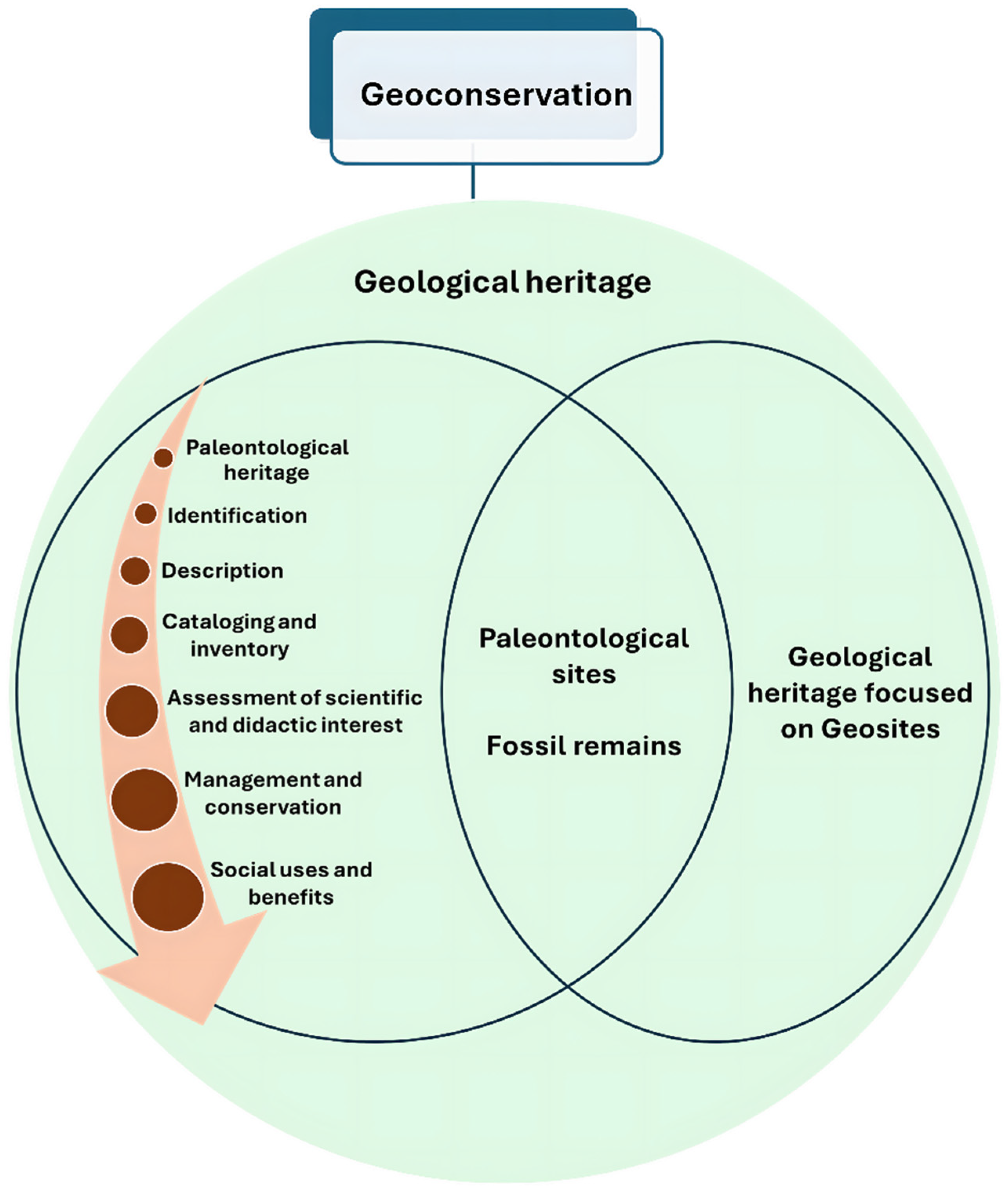
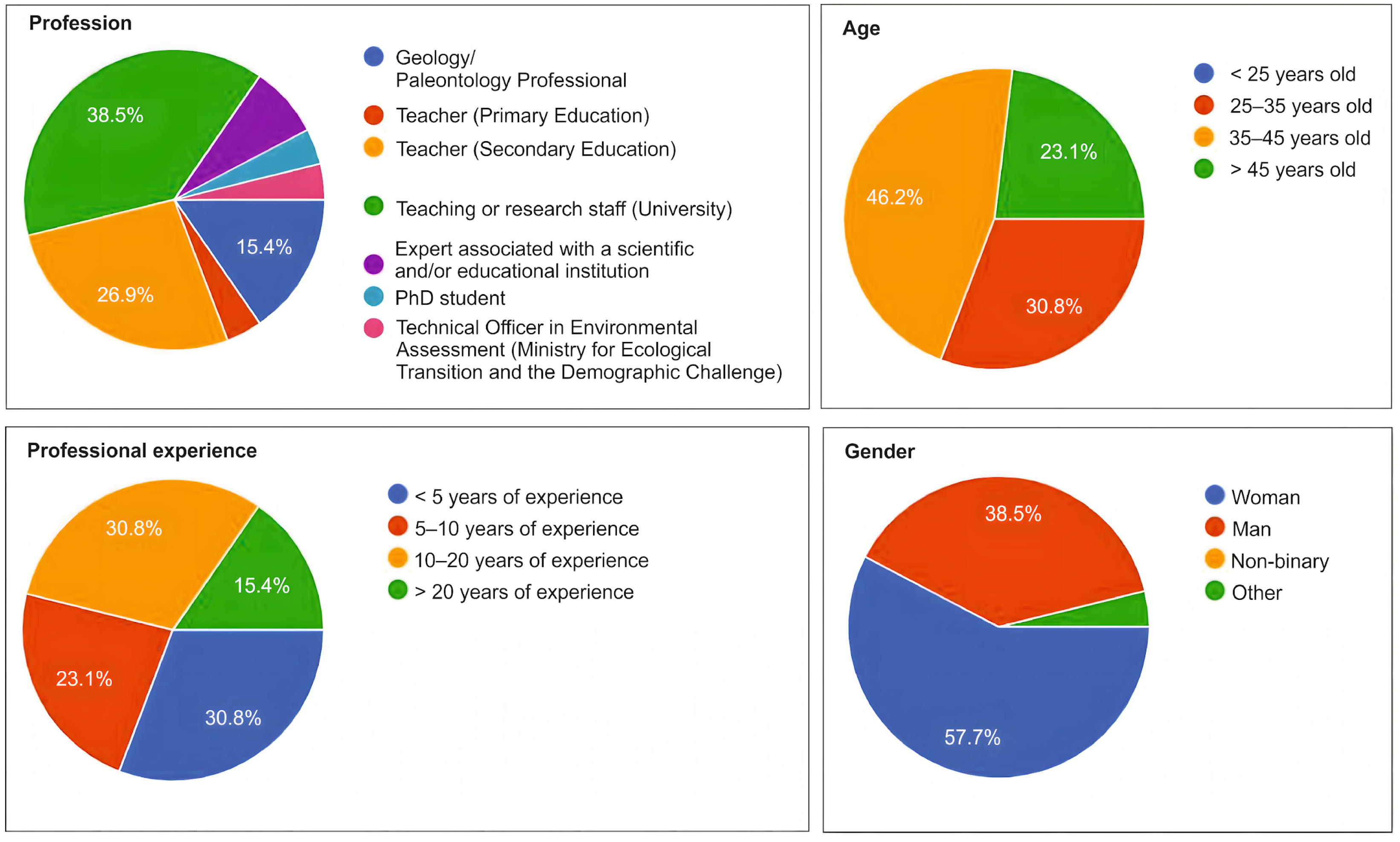
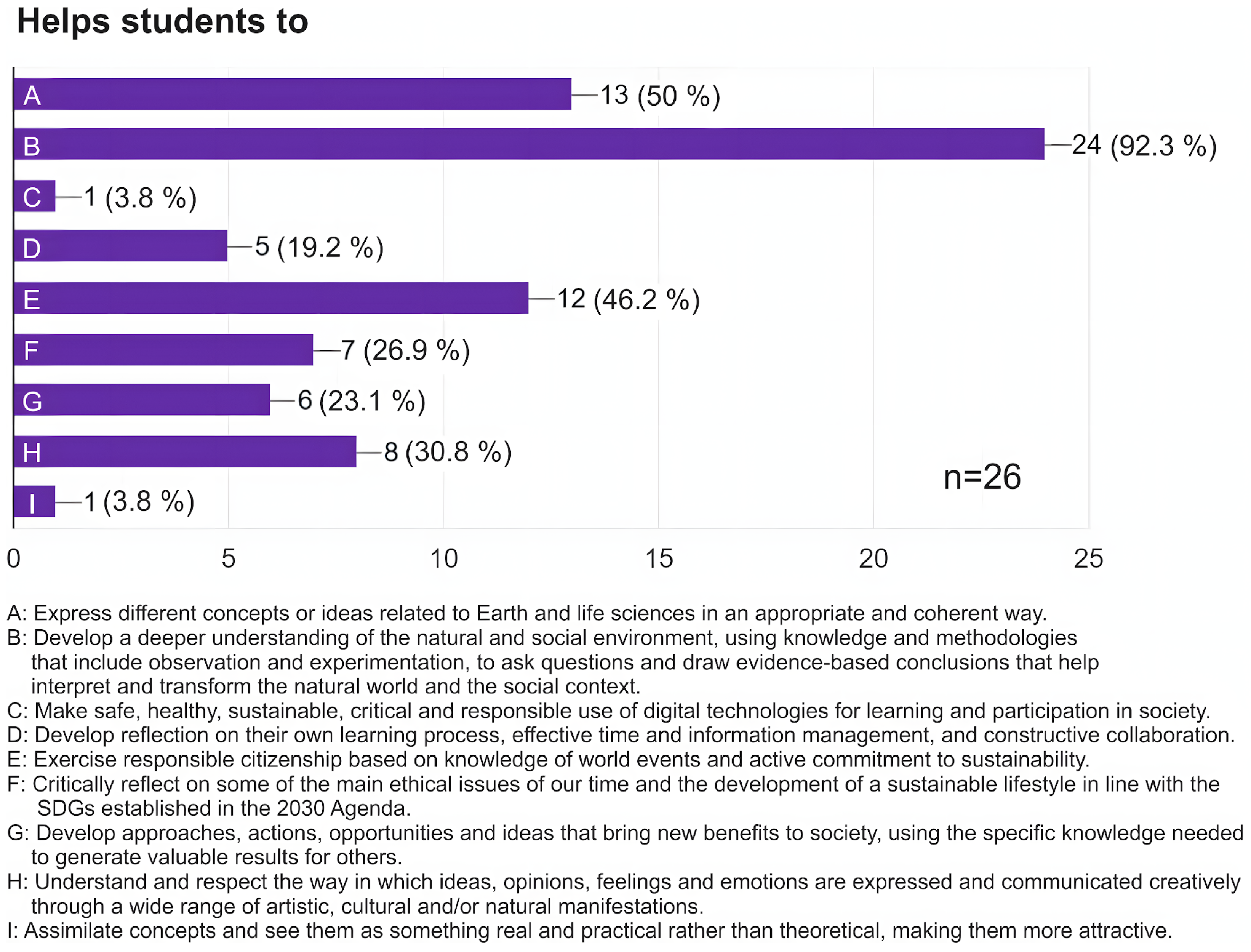
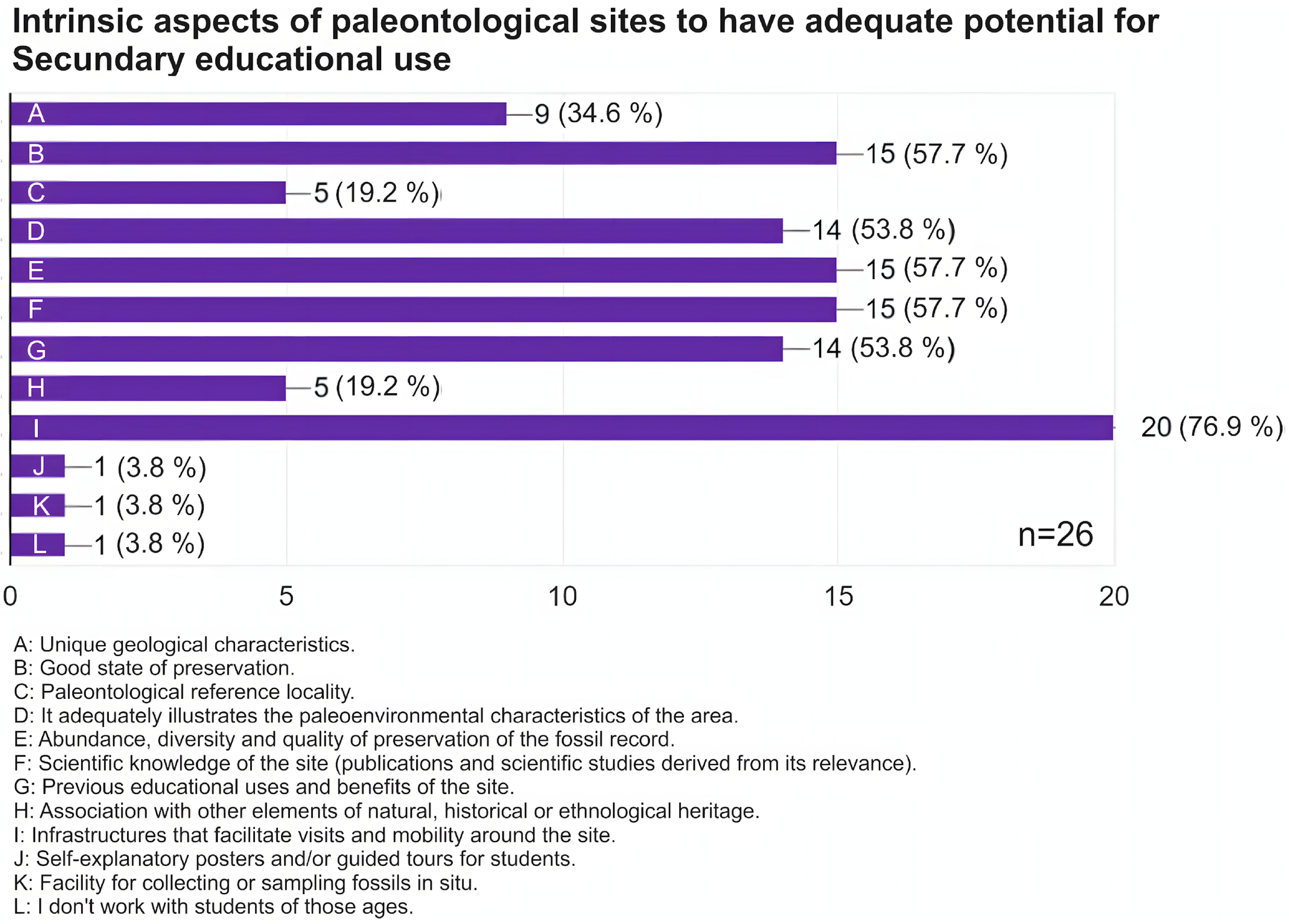


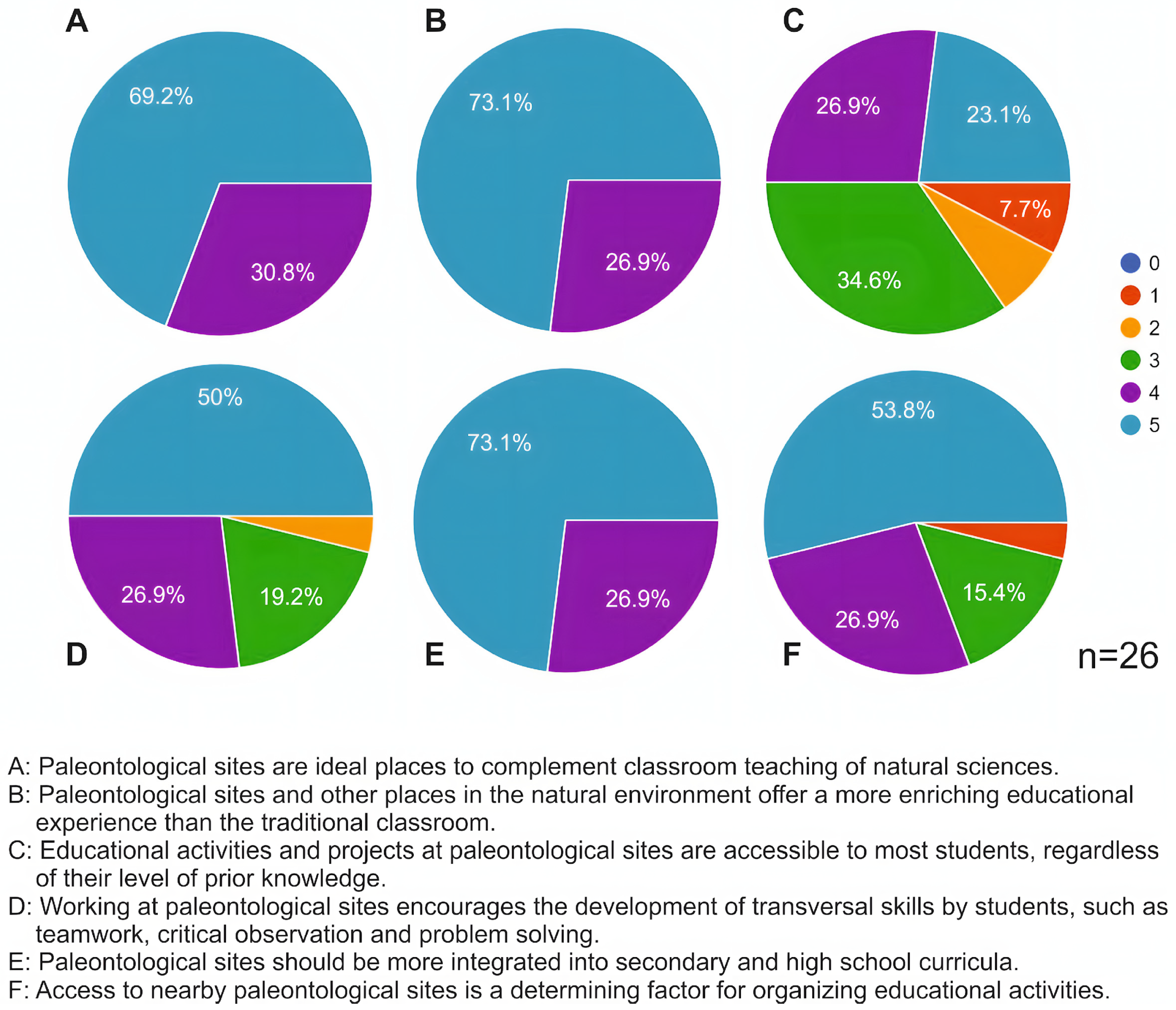
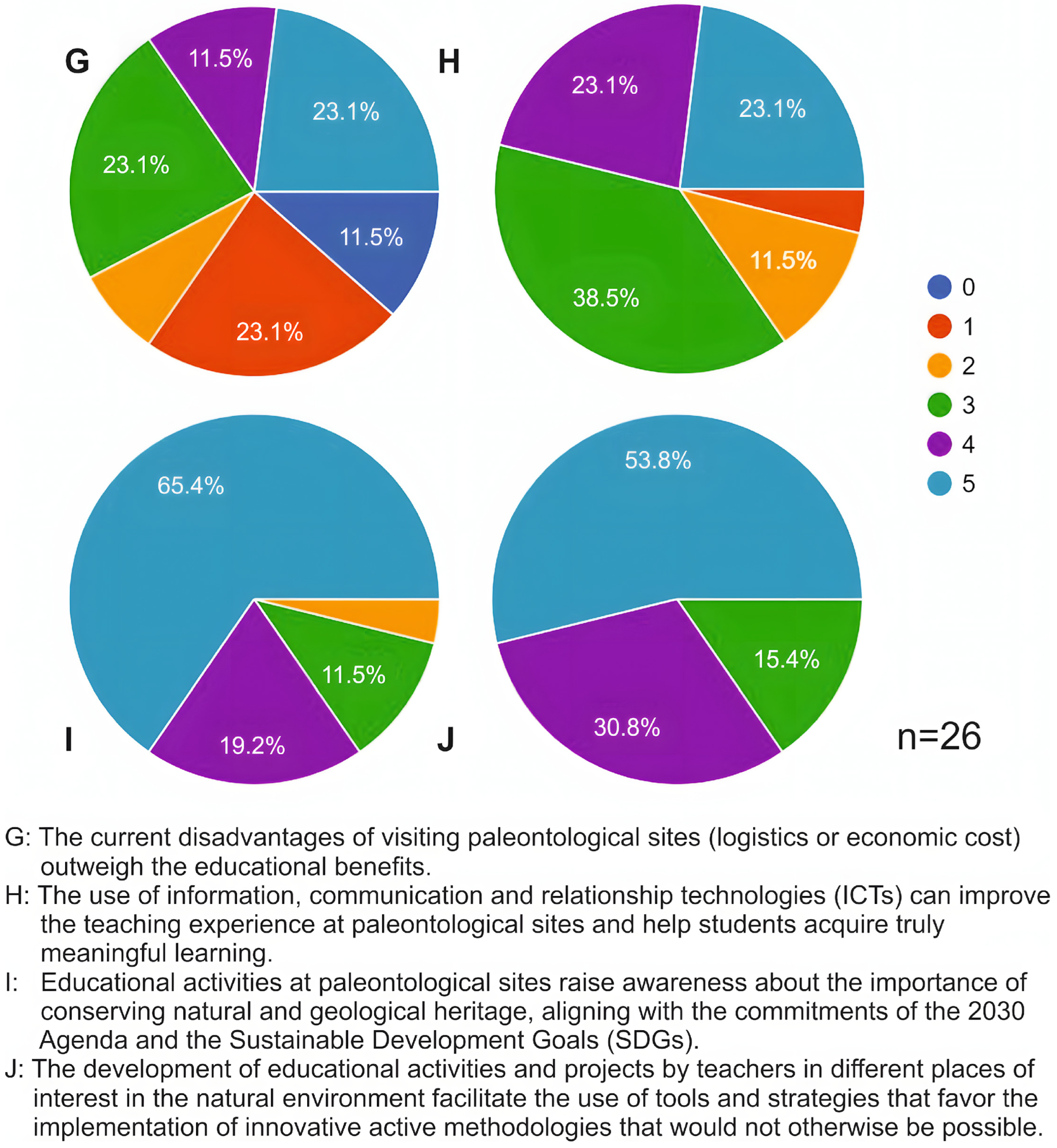
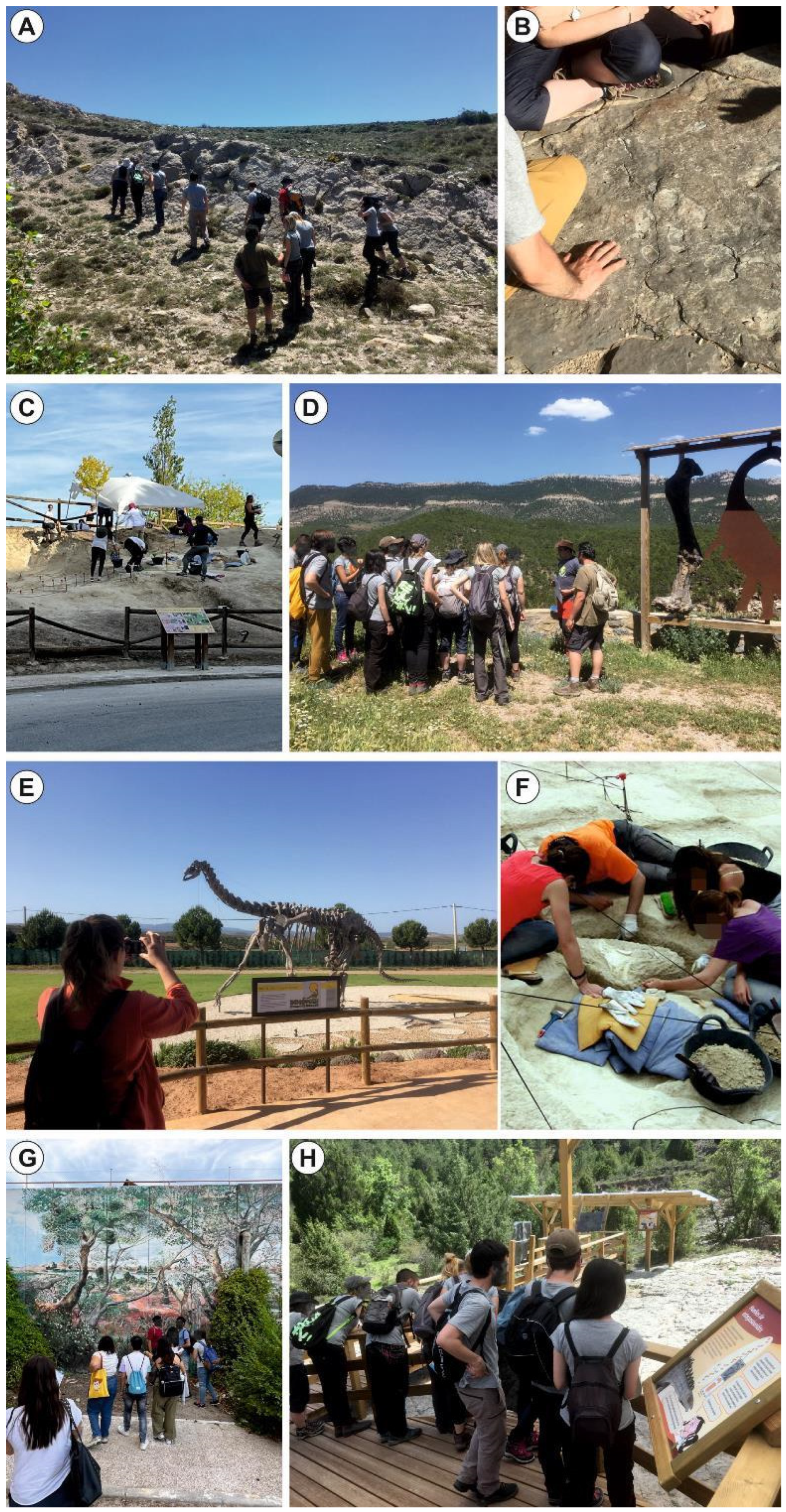
| Name and location of the UNESCO Global Geoparks in Spain | |
| Maestrazgo (Aragón) | Molina Alto-Tajo (Castilla-La Mancha) |
| Cabo de Gata-Níjar (Andalucía) | El Hierro (Islas Canarias) |
| Sobrarbe-Pirineos (Aragón) | Lanzarote y Archipiélago Chinijo (Islas Canarias) |
| Sierras Subbéticas (Andalucía) | Las Loras (Castilla y León) |
| Costa Vasca (País Vasco) | Origens (Cataluña) |
| Sierra Morena de Sevilla (Andalucía) | Montañas do Courel (Galicia) |
| Villuercas-Ibores-Jara (Extremadura) | Granada (Andalucía) |
| Cataluña Central (Cataluña) | Volcanes de Calatrava (Castilla-La Mancha) |
| Cabo Ortegal (Galicia) | |
| Some paleontological sites of special interest in the Iberian Peninsula | |
| Yacimientos paleontológicos del Cámbrico de Murero (Aragón). Visitable. | Yacimientos pseudodokárstico del Mioceno superior del Cerro de los Batallones (Madrid). Visitable. |
| Yacimiento de vertebrados del Cretácico inferior de Las Hoyas (Castilla La-Mancha). Visitable. | Cueva de El Sidrón (Asturias). Visitable. |
| Yacimiento paleontológico del Ordovícico en el túnel del Fabar (Ribadesella, Asturias) | Estratotipo del Vallesiense, Cuenca del Valles Penedés (Cataluña). Visitable. |
| Yacimiento de dinosaurios del Cretácico superior Lo Hueco (Castilla-La Mancha). Visitable. | Yacimiento paleontológico continental y mineralización de azufre del Mioceno en Libros (Teruel). Visitable. |
| Yacimientos paleontológicos del Mioceno de Somosaguas (Madrid). Visitable. | Yacimiento de homínidos del Cuaternario de la Sierra de Atapuerca (Castilla y León). Visitable. |
| Yacimiento paleontológico de Fonelas P-1 (Andalucía). Visitable. | Yacimiento paleontológico de Venta Micena (Andalucía) |
| Yacimiento paleontológico de Barranco León-5 (Andalucía) | Yacimiento paleontológico de Fuente Nueva-3 (Andalucía) |
| Yacimiento paleontológico ediacárico en el Arroyo de la Fuente (Extremadura) | Desfiladero del río Ruecas en el sinclinal de Santa Lucía (Extremadura) |
Disclaimer/Publisher’s Note: The statements, opinions and data contained in all publications are solely those of the individual author(s) and contributor(s) and not of MDPI and/or the editor(s). MDPI and/or the editor(s) disclaim responsibility for any injury to people or property resulting from any ideas, methods, instructions or products referred to in the content. |
© 2025 by the authors. Licensee MDPI, Basel, Switzerland. This article is an open access article distributed under the terms and conditions of the Creative Commons Attribution (CC BY) license (https://creativecommons.org/licenses/by/4.0/).
Share and Cite
Acedo, A.; Fesharaki, O.; García-Frank, A. The Didactic Potential of Paleontological Immovable Heritage for Secondary Education (Middle School and High School) Students in Spain: Assessment from Learning and Research Approaches. Geosciences 2025, 15, 164. https://doi.org/10.3390/geosciences15050164
Acedo A, Fesharaki O, García-Frank A. The Didactic Potential of Paleontological Immovable Heritage for Secondary Education (Middle School and High School) Students in Spain: Assessment from Learning and Research Approaches. Geosciences. 2025; 15(5):164. https://doi.org/10.3390/geosciences15050164
Chicago/Turabian StyleAcedo, Abel, Omid Fesharaki, and Alejandra García-Frank. 2025. "The Didactic Potential of Paleontological Immovable Heritage for Secondary Education (Middle School and High School) Students in Spain: Assessment from Learning and Research Approaches" Geosciences 15, no. 5: 164. https://doi.org/10.3390/geosciences15050164
APA StyleAcedo, A., Fesharaki, O., & García-Frank, A. (2025). The Didactic Potential of Paleontological Immovable Heritage for Secondary Education (Middle School and High School) Students in Spain: Assessment from Learning and Research Approaches. Geosciences, 15(5), 164. https://doi.org/10.3390/geosciences15050164






